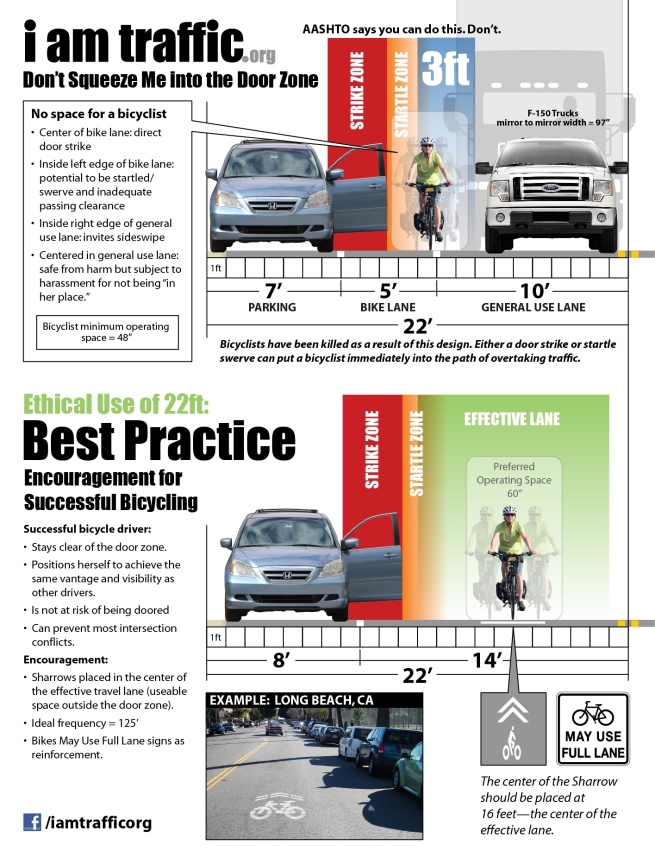In the summer of 2015, the city under Mayor Kevin Faulkner , announced an ambitious scheme to repave or repair 1,000 miles of city streets within five years. The city government also launched a slick website where residents can track the progress of projects. In 2017, several streets in Pacific Beach including parts to two major east-west arterials, Balboa and Grand Avenue, received new pavement and new markings. A number of local streets, Lamont being one of them, also received a brand spankin’ new ribbon of asphalt. There seems to be a delay of a few weeks up to even over a month for a striping crew to return and paint the lane markings, turn pockets, and crosswalks. One of the things on my to-do list was to consider drafting up an email to the city requesting they look into adding shared-lane markings (i.e, Sharrows) and “Bikes May Use Full Lane” signs to both Balboa and Grand. Turns out I was too late. Over the weekend – or very late last week, a striping crew started painting hazardous door zone bike lanes (DZBLs) on Grand Avenue from Ingraham to Olney. To get an idea of what is where, see the map below. Click on each color for reference.
On these two roadways, a bicyclist wishing to travel straight will in most cases will be using the right hand most lane unless it is a right turn only lane, in which bicyclists are only allowed use them when turning right. The safest position to avoid the hazards of opening car doors, drive outs, right hooks, left crosses, and close in-lane passes is to control the lane. Both of these roads contain more driveways than can be counted, constant intersections, and permitted on-street parking vehicle storage, and to add to that – the width of the lanes are not even close to “sharable,” therefore CVC 21202 (the commonly misunderstood far to right law) does not apply. CVC 21208 (the mandatory bike lane law) obviously doesn’t apply on most of these roads either. Parts of Grand Avenue, which are outside the scope of the current resurfacing projects, already have hazardous door zone bike lanes.
Oddly enough, the portion between Cass Street and Ingraham – just west of the brand new hazardous DZBLs, contain no bike lanes at all but have a shared-lane marking (sharrows) painted at the beginning of every major intersection. The lateral position of the sharrows, to the city’s credit, were placed quite well in the center of the lane away from the door zone. The only problem with the small section that received this treatment is the lack of BMUFL signs (optional anyways) and the markings are only placed at the beginning of each block after a major intersection which is over 500 feet! These intervals do not meet the California MUTCD’s requirements which require the intervals between markings be no more than 250 feet. Even if these sharrows were not present, a bicyclist is still allowed to control the full lane for his or her safety and visibility.
DZBLs also exist, but have been installed for some time now, between Mission and Cass (toward the ocean) and in the vicinity of Mission Bay High School (toward the I5 freeway).
Two highly mandatory pieces of reading discussing the hazards of door zone bike lanes are Paul Schimek’s recent paper and Wayne Pien’s 2004 paper. For those who don’t want to spend so much time reading, the folks who run the I Am Traffic page (see links library) have a great scaled infographic. Surprisingly these hazards are approved to use by AASHTO and are used not just in San Diego but in other cities across the US. BikeSD, one of the local advocacy groups even seems to be okay with them. Because hey, more bicyclists (no matter the increase in injuries or deaths) is good, right?
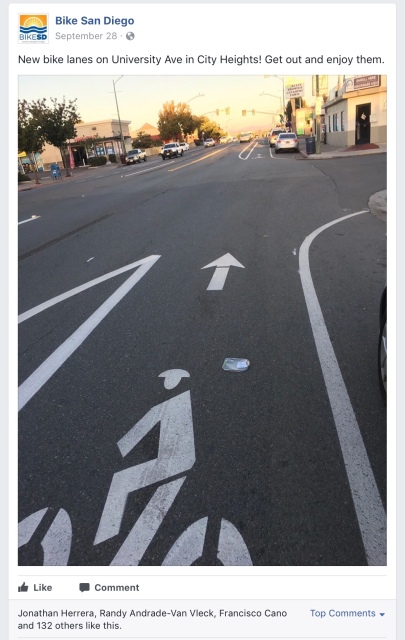
Here are some “before and afters” on Grand. Balboa itself doesn’t have any bicycle lanes or sharrows.
- SE corner of Grand Ave and Ingraham St, looking NE, also a MTS bus stop. There is also a Wendy’s restaurant here with and driveway commonly used for both entry and exit to the parking lot and another driveway that’s specifically an exit for the drive-thru.
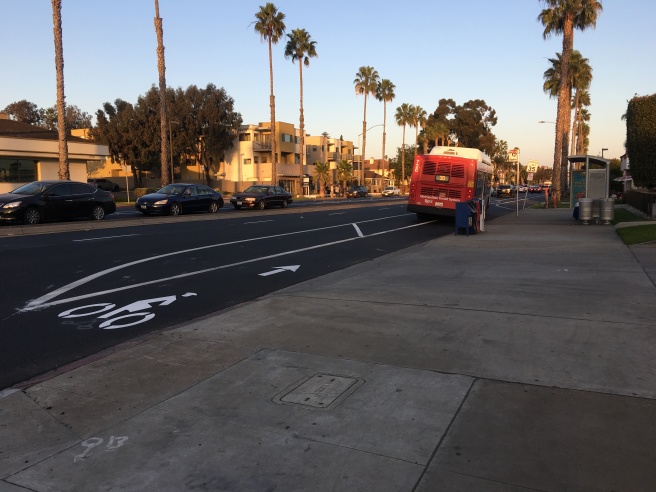
- Driveway exiting KFC restaurant (closest) and a residential driveway (farthest) leading to a multi-family housing unit. Notice the odd “hash marks” these are usually used for “buffers” in bike lanes.
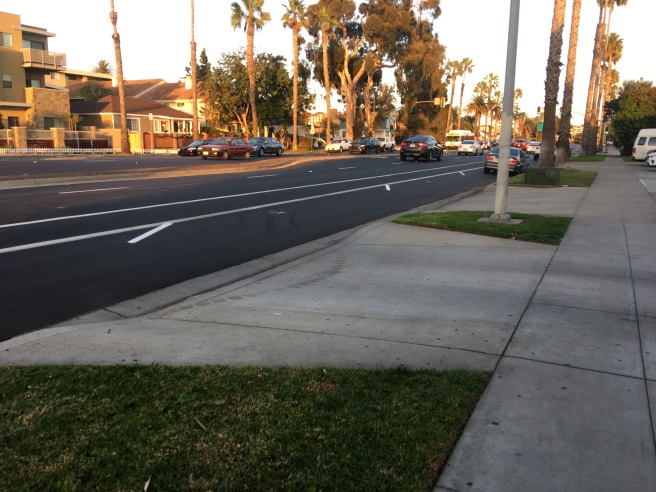
- SW corner of Grand and Jewell, looking NW. Notice the bike lane drops but the fog line is painted with an odd curve and sloppily extends through the limit line.

- Other side of above intersection, where the bike lane “starts” again, now looking East.

- Intersection of Grand and Lamont, still looking East. Note at this corner there is a gas station which sees lots of vehicles entering and exiting Grand. Right turn traffic volume onto Lamont is high too. The Google Streetview image was taken out in a different lane which makes comparing the two views somewhat confusing.

- The other side of the Grand and Lamont. Note the bus stop. It appears the slash marks indeed are to add a “buffer” to the bike lane.
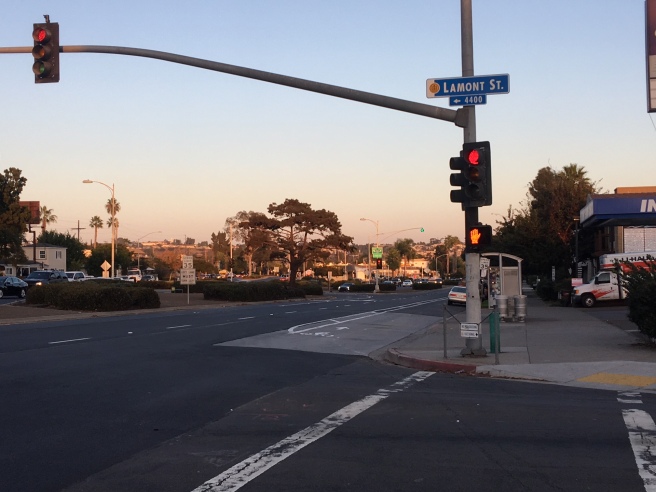
- Still going east, and facing east on Grand, slightly passed the MTS bus stop. There is absolutely not enough space. The buffer is still in the “startle zone” at best, and at worst, it’s very much in the door zone. If a cyclist were riding in this bike lane, the black car would also be passing them with under three feet of clearance, which is supposed to be against the law. The city not only designed a hazardous door zone bike lane but is encouraging traffic movements in violation of a CVC law. Bicyclists do not have the minimum required operating space here either. Also note a few spots in front of the parked pickup, there is a motorcycle parked with its back wheel against the curb and the front wheel intruding into the bicycle lane. A Ford F-150, not including the mirrors is over six feet wide. A Harley Davidson Road Glide is a surprising 7.8′ long.
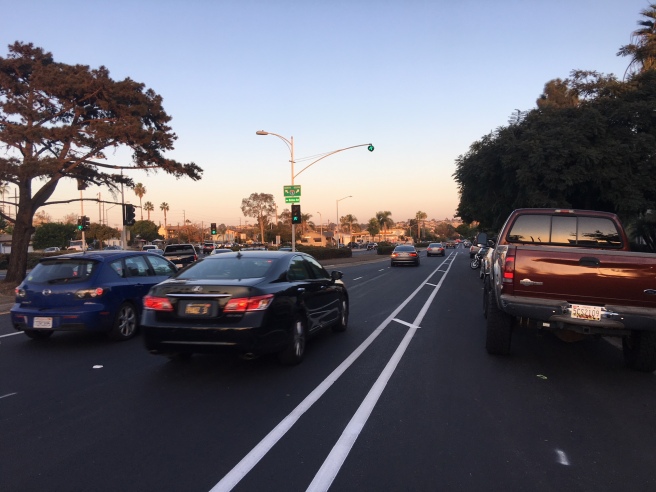
- The last photo looking eastbound is a panorama just to show the bike lane dropping very early before the next intersection. The striping crew seems to be planning to place another odd curved fog line here as well.

Bike lane or not, door zones are never safe places for a bicyclist to ride. Even if the faux buffers were installed to the right instead of the left to try to squeeze the bicyclist further left, they still run the risk of injury by being startled by an opening car door. There isn’t enough space in this right of way, period.
The city should take steps to tear out this garbage immediately and either return it to normal travel lanes with no treatment or follow the CA-MUTCD’s requirements for placing sharrows and/or BMUFL signs.
Bicyclists who are aware of the risks of riding in the door zone will probably choose to not use the bike lanes and will control the lane as normal. I, for one, will continue to do this. However, bicyclists who choose to do this will risk harassment from motorists (aka, why aren’t you in the bike lane?) and also risk a CVC 21208 (mandatory bike lane law) ticket even though such could be thrown out in court with the right expert witnesses.
Bicyclists who are not aware of the risks of the door zone in general will experience increased risk of being doored and all the other potential hazards associated with edge riding. Unfortunately, if a bicyclist is doored, chances are they will be severely injured or even killed. The incident will not be counted as a typical bicycle-motor vehicle crash either. Let’s also not forget about all the traffic entering and exiting the various driveways that serve both residential and commercial properties and the motorists scouting the street looking for parallel parking spaces.
Edit: I’ve added the infographic from I Am Traffic since the link above doesn’t direct properly (thanks Google)
